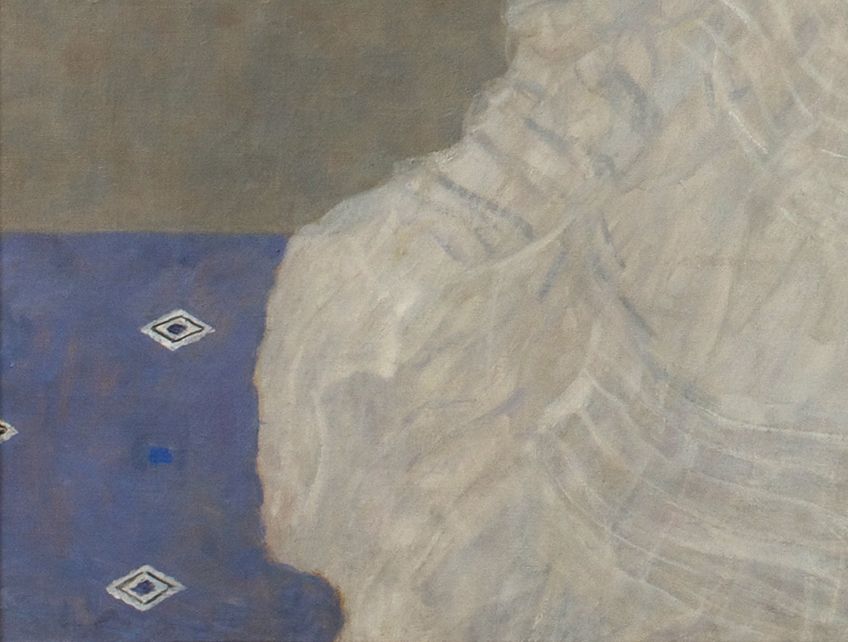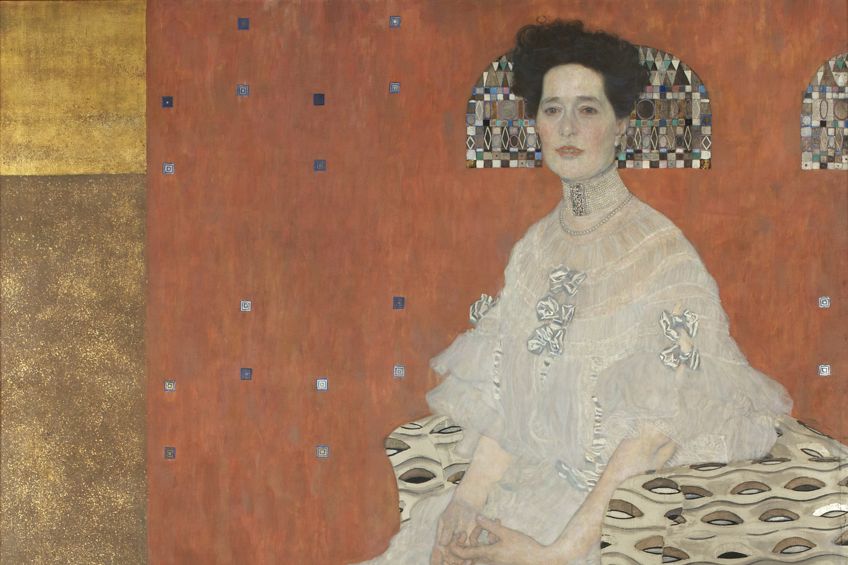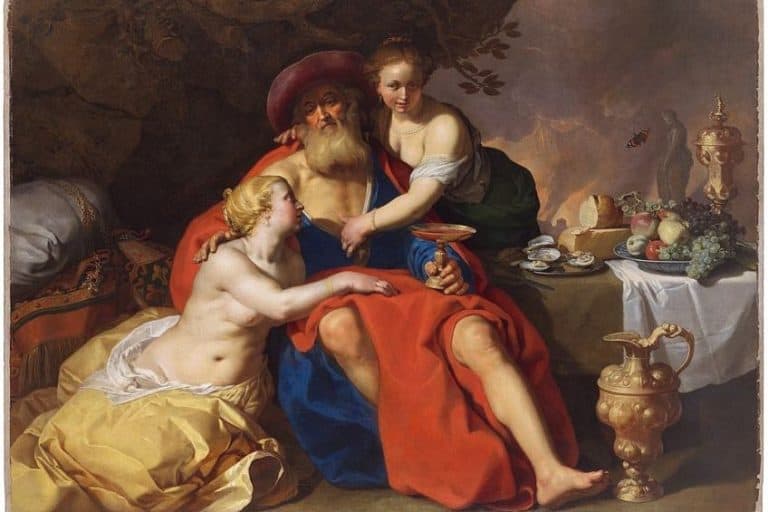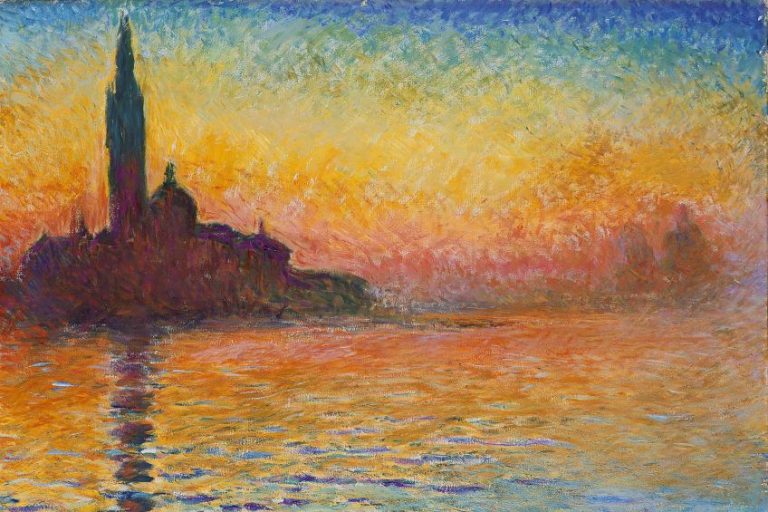“Portrait of Fritza Riedler” by Gustav Klimt – A Detailed Art Analysis
Portrait of Fritza Riedler, created by Gustav Klimt in 1906, stands as a quintessential example of the artist’s Golden Phase, where his distinctive use of gold leaf and intricate patterns brought a mesmerizing opulence to his work. This portrait, housed in the Belvedere Museum in Vienna, captures the elegance and sophistication of Viennese society at the turn of the century. Klimt’s portrayal of Fritza Riedler, a prominent Viennese socialite, is not just a testament to her status but also a reflection of the artist’s innovative approach to composition and texture, blending elements of realism with decorative symbolism. The painting’s rich, shimmering surface and the poised, almost ethereal presence of the sitter encapsulate the era’s fascination with beauty, luxury, and the emerging modernist aesthetic.
Key Takeaways
- Klimt’s portrait was created in 1906, deeply rooted in Art Nouveau.
- The use of gold leaf and intricate patterns are notable features.
- The painting reflects societal views and remains at the Belvedere Palace.
Context and Historical Significance
| Artist | Gustav Klimt (1862 – 1918) |
|---|---|
| Date Created | 1906 |
| Medium | Oil on canvas |
| Genre | Portrait |
| Period/Movement | Vienna Secession and Art Nouveau |
| Dimensions (cm) | 153 × 133 |
| Series/Versions | Single version |
| Where Is It Housed? | Belvedere Museum, Vienna, Austria |
| What It Is Worth | Not publicly auctioned; significant cultural and historical value |
Gustav Klimt’s Portrait of Fritza Riedler, painted in 1906, remains a significant work within the realm of Art Nouveau. This portrait exemplifies Klimt’s distinctive use of gold leaf and intricate patterns, evoking a sense of elegance and grandeur. Fritza Riedler is depicted in a seated position, her composed demeanor contrasting with the rich textures surrounding her.

Klimt’s meticulous attention to geometric blocks of color in the background adds a layer of depth to the painting. The elaborate armchair and decorative headdress showcase his imaginative approach and deep understanding of form and color. The portrait not only highlights Fritza Riedler as a muse but also reflects the societal views of women during that period.
Housed at the Belvedere Palace and Museum in Vienna, this oil on canvas painting embodies a pivotal moment in Klimt’s golden period. His innovative style and the painting’s historical significance continue to captivate art enthusiasts and scholars alike, cementing its place in art history.
Gustav Klimt and the Art Nouveau Movement
Gustav Klimt was a prominent figure in the Art Nouveau movement. Art Nouveau, known for its decorative and flowing designs, heavily influenced his work. Klimt was famous for his unique use of gold leaf, which added a luxurious feel to his paintings. In Portrait of Fritza Riedler, he combined intricate patterns with rich, gold accents. Klimt often focused on the beauty of women in his portraits. His works from this period, including this portrait, are characterized by their elaborate detail and symbolic elements. The use of gold and geometric patterns in this piece are hallmarks of Klimt’s style during his golden period. This painting not only highlights his artistic skills but also represents a significant era in his career.

Austria’s Cultural Landscape in the Early 20th Century
In the early 1900s, Vienna was a hub for art and culture. The city was home to many intellectuals and artists who were pushing the boundaries of traditional art forms. The Secessionist movement, of which Klimt was a leading member, aimed to break away from the conservative norms of the time. The portrait was created in 1906, during a period of great innovation in Vienna. The city’s thriving cultural scene provided a fertile ground for Klimt’s creativity. The Art Nouveau style, with its emphasis on new and modern expression, found a perfect setting in this progressive environment.
Through his work, Klimt captured the spirit of his time, making Portrait of Fritza Riedler a piece that not only represents his personal artistry but also the broader cultural shifts in early 20th century Austria.
Artistic Elements of the Portrait
Gustav Klimt’s Portrait of Fritza Riedler is a striking example of his unique style, with its detailed portrayal of the subject, innovative composition, symbolic patterns, and influences from Egyptian art.

Subject Matter
The portrait features Fritza Riedler in an elegant seated pose. Klimt’s meticulous attention to detail brings out the delicate features and graceful demeanor of the subject. Her dress is adorned with intricate lace, adding a sense of luxury. The way Riedler is seated, exuding both confidence and poise, highlights her status and personality.
The soft and flowing forms Klimt used emphasize her femininity, capturing a timeless sense of beauty.

Composition and Use of Color
Klimt’s composition in this portrait is marked by its decorative style and use of gold and silver. He employs geometric patterns in the background, lending an ornate and almost mosaic-like texture to the piece. The mixture of gold leafing against the softer tones of Riedler’s dress creates a striking visual balance.
The flowing white dress contrasts with the rigid, colorful background, drawing the viewer’s focus directly to the subject.

Symbolism and Patterns
Symbolism is a key element in Klimt’s work. In Portrait of Fritza Riedler, the repetitive patterns and luxurious use of gold may symbolize wealth and status. The patterns on her dress and in the background create a sense of harmony and unity.
Klimt’s use of decorative motifs, such as spirals and floral designs, adds layers of meaning and beauty to the portrait, making it a rich visual experience.

Influence of Egyptian Art
The influence of Egyptian art is evident in the portrait. Klimt’s use of side profiles in some of his subjects, the hieroglyphic-like patterns, and the rigid, almost frame-like composition hint at Egyptian artistry. The gold leaf, reminiscent of the adornments of Egyptian pharaohs, adds a regal quality.
These elements come together to create a timeless and historically rich work that bridges modernism with ancient artistic traditions.

Fritza Riedler and Society
Fritza Riedler’s portrait by Gustav Klimt reflects both the personal and societal influences of her time. The painting speaks to the role of women in early 20th-century Vienna and the impact of the Riedler family within Austrian society. Fritza Riedler was the wife of Austrian mechanical engineer Alois Riedler. Her presence in Klimt’s work signifies her social standing and importance. Fritza’s life is less documented compared to Klimt’s more famous muses like Adele Bloch-Bauer I. However, her depiction in the portrait reveals much about her status and elegance. She is portrayed in an elaborate gown, highlighting her refined taste and the wealth of her family. Klimt’s meticulous attention to her attire and posture suggests she was a figure of prominence in Viennese society.
The sophisticated representation aligns with the status of her husband, who was an influential engineer.
Representation of Women in Klimt’s Works
Gustav Klimt often depicted women in a stylized, lavish manner. His paintings feature rich details and intricate designs, focusing on female beauty and elegance. In the Portrait of Fritza Riedler, these elements are evident through the detailed gown and the abstract background, combining realism with decorative flair. Klimt’s women are often posed in a way that mixes vulnerability and strength. Fritza is seated confidently, embodying the modern woman’s shifting roles during the early 1900s. This portrayal contrasts with more traditional depictions of women, suggesting a nuanced view of femininity and societal roles.

The Riedler Family and Their Influence
The Riedler family was significant in Austrian society, primarily due to Alois Riedler’s contributions to engineering. His advancements and status afforded the family a respected position. This influence extended into cultural spheres, as seen in their commissioning of Klimt, a leading artist of the time. The portrait encapsulates their societal standing and interest in the arts. It also reflects how families like the Riedlers played a role in fostering and supporting artistic endeavors. Fritza’s portrait serves as a testament to the family’s impact and standing, contributing to the rich cultural tapestry of Vienna.
By understanding Fritza Riedler’s social background, representation, and familial influence, one can appreciate the nuanced aspects of her portrait.
Legacy and Conservation
The Portrait of Fritza Riedler by Gustav Klimt continues to hold a prominent place in art history due to its unique style and the artist’s influential techniques. This section covers where it has been displayed and its ownership history, as well as its impact on reproduction and the art market.

Exhibitions and Ownership
The Portrait of Fritza Riedler is housed in the Belvedere Palace and Museum in Vienna, offering visitors a chance to admire Klimt’s work up close. This oil-on-canvas painting, measuring 153 cm by 133 cm, is a significant piece in their collection. Over the years, it has been featured in many international exhibitions, allowing it to gain global recognition. The painting reflects Klimt’s fascinating use of gold leaf, a hallmark of his Art Nouveau style.
It has traveled to major art shows, contributing to its legacy as one of Klimt’s celebrated works.
Reproductions and the Art Market
Portrait of Fritza Riedler has been reproduced in various formats, including posters, prints, and digital images. These reproductions allow a wider audience to appreciate Klimt’s artistry and make the artwork accessible beyond museum walls. Reproductions have contributed to the painting’s popularity and increased its market value. The original remains a valued piece, often referenced in art auctions and scholarly work. These reproductions also help in preserving the painting’s legacy by sparking interest in Klimt’s other works, including the famous The Kiss. The Art Nouveau style and the specific details of the portrait, such as the intricate patterns and use of gold, continue to inspire modern artists, cementing Klimt’s influence in contemporary art.

Portrait of Fritza Riedler is a masterful representation of Gustav Klimt’s artistic brilliance and his unique ability to blend realism with ornate symbolism. This artwork not only immortalizes the grace and poise of its subject but also serves as a reflection of the opulent cultural milieu of early 20th-century Vienna. Through his meticulous attention to detail and innovative use of gold leaf, Klimt created a piece that transcends mere portraiture, offering viewers a glimpse into the lavish and complex world of his time. The portrait remains a testament to Klimt’s legacy, encapsulating the elegance, sophistication, and artistic innovation that continue to captivate audiences today.
Frequently Asked Questions
Which Artistic Style Is the Portrait of Fritza Riedler Painted In?
The Portrait of Fritza Riedler is painted in the Art Nouveau style. Gustav Klimt often used this style, which includes decorative elements and fluid, organic forms. The painting prominently features gold leaf, adding to its intricate and luxurious appearance.
How Does Portrait of Fritza Riedler Reflect Gustav Klimt’s Signature Style?
The portrait reflects Klimt’s signature style through its use of gold leaf and ornamental patterns. It showcases a blend of fine detail and flat, decorative elements. Klimt’s preference for depicting women in a highly stylized manner is evident in this work.
Who Was Fritza Riedler and What Was Her Relationship to Gustav Klimt?
Fritza Riedler was the subject of Klimt’s painting. She was a prominent Viennese society figure. While there is little detailed information on their personal relationship, Riedler’s status likely connected her to Klimt, known for his portraits of high-society women.
What Are the Notable Artistic Features of the Portrait of Fritza Riedler by Gustav Klimt?
Notable features include the mosaic-like decorations and the use of gold leaf. These give the painting a shimmering, ornate quality. The portrayal of Riedler combines realistic facial features with abstract patterns, emphasizing both her individuality and decorative elegance.
Isabella studied at the University of Cape Town in South Africa and graduated with a Bachelor of Arts majoring in English Literature & Language and Psychology. Throughout her undergraduate years, she took Art History as an additional subject and absolutely loved it. Building on from her art history knowledge that began in high school, art has always been a particular area of fascination for her. From learning about artworks previously unknown to her, or sharpening her existing understanding of specific works, the ability to continue learning within this interesting sphere excites her greatly.
Her focal points of interest in art history encompass profiling specific artists and art movements, as it is these areas where she is able to really dig deep into the rich narrative of the art world. Additionally, she particularly enjoys exploring the different artistic styles of the 20th century, as well as the important impact that female artists have had on the development of art history.
Learn more about Isabella Meyer and the Art in Context Team.
Cite this Article
Isabella, Meyer, ““Portrait of Fritza Riedler” by Gustav Klimt – A Detailed Art Analysis.” Art in Context. July 5, 2024. URL: https://artincontext.org/portrait-of-fritza-riedler-by-gustav-klimt/
Meyer, I. (2024, 5 July). “Portrait of Fritza Riedler” by Gustav Klimt – A Detailed Art Analysis. Art in Context. https://artincontext.org/portrait-of-fritza-riedler-by-gustav-klimt/
Meyer, Isabella. ““Portrait of Fritza Riedler” by Gustav Klimt – A Detailed Art Analysis.” Art in Context, July 5, 2024. https://artincontext.org/portrait-of-fritza-riedler-by-gustav-klimt/.











